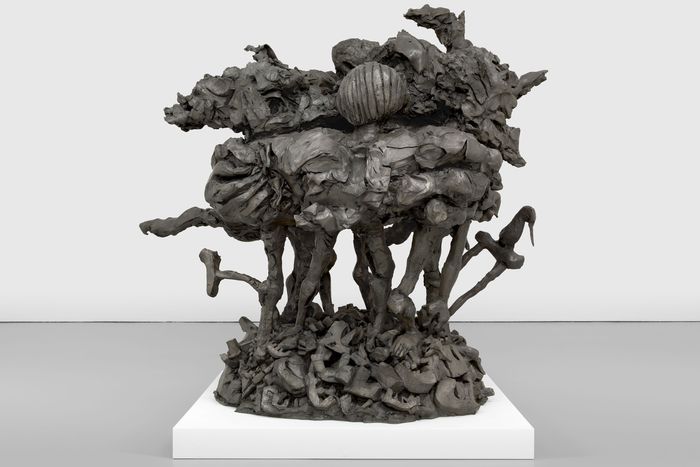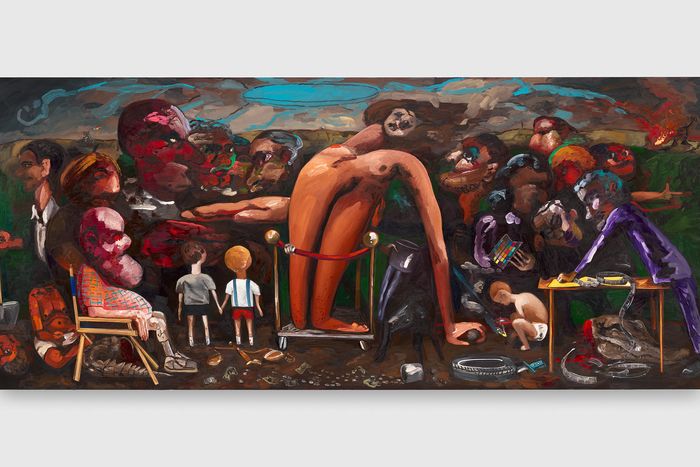
Dana Schutz was pilloried in 2017 when the Whitney exhibited Open Casket, a smeared depiction of a mangled body that instantly called to mind Emmet Till in his coffin. I’m sure it was the first time many people had even heard of this 47-year-old painter and sculptor — people who may not have known or cared about her reputation as one of the most compelling American artists of the 21st century. Now she is also one of its most controversial, her name forever attached to a scandal. She had always painted greatly distorted bodies and socially charged subject matter, even if Open Casket wasn’t particularly convincing as a painting. But the controversy had less to do with her work than with decisions made by the curators of the Biennial. In many ways, she was a scapegoat, paying for the art world’s institutional racism.
So it is fortunate for us that she carried on and reclaimed her name and reputation: piece by piece, show by show. Her latest solo endeavor at David Zwirner, “Jupiter’s Lottery,” features a tainted artist who seems eager to plant enormous stakes in art history. Her more ardent paintings left me speechless: huge, luridly iridescent moonscapes, slathered surfaces piled up with greasy paint, giant marionette-like figures with spidery limbs and oversize heads. Her ambition is massive, Kiefer like. There are Olympian battle scenes and brawls, as well as tense, quiet interludes in between.
The show is made up of 15 large paintings; one, The Gathering, is as big as a barge. There are seven bronzes, including Sea Group, an enormous masterpiece of encircled figures facing inward, entwined, each struggling against the other, with a horse rising up, a crutch with a bird perched on it, all in a psychic dance of life and death. It was made by Schutz standing inside the thing, forming and adding clay, melding this wild bacchanalia. It would look great in a fountain on the Mall in Washington, D.C.
The Gathering is 21 feet by nine feet, the second-biggest painting I saw all year after a cool Roy Lichtenstein at Gagosian. It centers on a twisted female figure on a small platform on wheels, cordoned off by velvet rope. Her Picasso-like head twists upside down beneath a large blue sun. She is flanked on either side by groups of men like Christ in The Last Supper, though these acolytes grimace and grin evilly; and like Leonardo’s Christ, her hands extend in different directions, blessing or protecting her children. On the left, a grumpy geezer grimaces from his rocker. On the right, a filmmaker pores over private footage.
It is tempting to see the female figure as Schutz: half-mad on her pedestal, torn, someone who is being deeply scrutinized and found wanting. There is a sense, too, that fate is arbitrarily having its way with her. Beneath the filmmaker’s table is a severed alligator head, and under the geezer’s chair is the tail — heads or tails, truth or fiction, right and wrong, all part of the same inscrutable beast.
Everyone in a Shutz painting is busy. Each figure seems to stand for something, even if it’s not always clear what— metaphors and visual riddles without obvious meaning. The Hill depicts a brown dune surrounded by artist-creatures making paintings. There are Miro bird-people, Cubistic figures, Boschian conjurations, all under a Renaissance sky. In The Walk, a face looks to the ground while a giant, red-nosed face grows on the other side of its head. These are pictures of hallucinatory states of mind, collective PTSD, and pandemonium — chaos held in check by Schutz’s sure touch and stately composition. Even the smaller works have the powerful churn of Spanish or Veronese old masters, but amid the tumult there are always moments of precision, things rendered with extreme legibility. Then the work erupts again.
The title of the show, “Jupiter’s Lottery,” is a reference to an Aesop’s tale in which the god sets up a lottery for wisdom. After Minerva wins, everyone gets jealous, and Jupiter responds by granting them folly. In other words, fools see themselves as wise. But the pursuit of wisdom, Schutz suggests, is another matter, especially, perhaps, for those who have confronted their mortality. Apples abound in this exhibition: a golden apple in The Chase, a man in high heels reaching for an apple in The Watch. The Love features an enormous Eve cupping a half-formed Adam. It is as if she were remaking him — and the world of which they are a part — with the knowledge she has gained.






